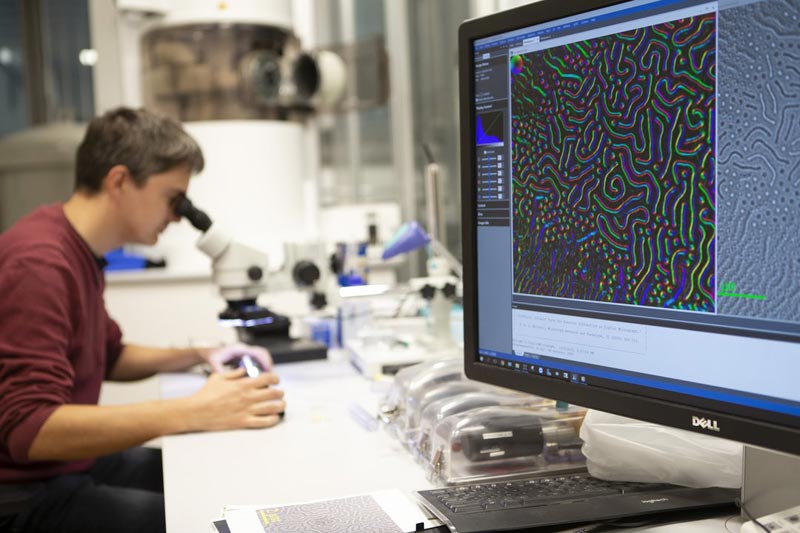

The measurements were carried out using the transmission electron microscope at the Augsburg Institute of Physics. The screen on the right shows spin textures.
© University of Augsburg
Study opens up new paradigm in skyrmionics research.
Researchers at the University of Augsburg and the University of Vienna have discovered co-existing magnetic skyrmions and antiskyrmions of arbitrary topological charge at room temperature in magnetic Co/Ni multilayer thin films. Their findings have been published in the renowned journal Nature Physics and open up the possibility for a new paradigm in skyrmionics research. The discovery of novel spin objects with arbitrary topological charge promises to contribute to advances in fundamental and applied research, particularly through their application in information storage devices.
Magnetic skyrmions are localised, stable topological magnetic spin textures resembling a tornado like whirl in a magnetic material. They can be very small, with diameters in the nanometre range, and behave as particles that can be moved, created, and annihilated, which makes them suitable for ‘abacus’-type applications in information storage and logic devices.

Magnetic skyrmions and antiskyrmions of arbitrary topological charge imaged experimentally (right) with Lorentz Transmission Electron Microscopy, and reproduced in micromagnetic simulations (left). Three-dimensional spin arrangement of the two-dimensional topological spin-objects by stereographic projection. © University of Augsburg
In their recently published article in Nature Physics entitled “Dipolar skyrmions and antiskyrmions of arbitrary topological charge at room temperature,” a group of researchers at the University of Augsburg led by Prof. Manfred Albrecht demonstrated that these spin objects can only be found in a distinct phase pocket in the stability diagram where the quality factor Q has a value of about 1, which is given by the ratio between the uniaxial magnetic anisotropy and the magnetic shape anisotropy. Thanks to extensive simulations carried out by Sabri Koraltan and colleagues from the simulation group at the University of Vienna, led by Prof. Dieter Suess, and supported by Dr Nikolai Kiselev from Forschungszentrum Jülich, researchers were also able to identify the exact reasons why spin objects can be found in the stability diagram, their underlying formation process, as well as the necessary material properties that can now also be applied to other material systems.
“We are very enthusiastic about the exciting insights gained by the discovery of these spin objects, which can be easily fabricated at room temperature. This is an outstanding scientific advance in the field of skyrmions and topological spin objects,” says Albrecht. These nanoscale skyrmionic spin textures provide extra degrees of freedom and can be embedded in thin-film devices enabling different applications ranging from unconventional computing to new storage concepts.
A further very essential aspect of spin objects is that a spin-polarised current induces their motion. When a charge current passes through a conducting magnetic material, the polarised electron spin will exert a torque on the magnetization known as the spin-transfer-torque. This torque can set the higher order skyrmions in motion. “Using micromagnetic simulations we could demonstrate the efficient control of the motion of these extraordinary spin objects, which opens up further opportunities for skyrmionic devices,” says Koraltan, a doctoral candidate from the University of Vienna’s computational group.
Lorentz transmission electron microscopy at the University of Augsburg was used extensively in the study, which is currently being expanded to visualise the current-induced motion of these multiple charge spin objects. “To what extent our predictions about their motion characteristics can be confirmed experimentally will be very exciting to research in the near future,” explains Mariam Hassan, a postdoctoral researcher at the University of Augsburg.
Wissenschaftliche Ansprechpartner:
Prof. Dr. Manfred Albrecht
Professor experimental physics IV
Telefon: +49 0821 598 – 3478
E-Mail: manfred.albrecht@uni-a.de
Prof. Dipl.-Ing. Dr. Dieter Süss
Professor for Computational Physics
Telefon: +43-1-4277-72730
E-Mail: dieter.suess@univie.ac.at
Originalpublikation:
M. Hassan, S. Koraltan, A. Ullrich, F. Bruckner, R.O. Serha, K.V. Levchenko, G. Varvaro, N.S. Kiselev, M. Heigl, C. Abert, D. Suess, and M. Albrecht: “Dipolar skyrmions and antiskyrmions of arbitrary topological charge at room temperature”, Nature Physics (2024).
DOI: 10.1038/s41567-023-02358-z
URL: https://www.nature.com/articles/s41567-023-02358-z












